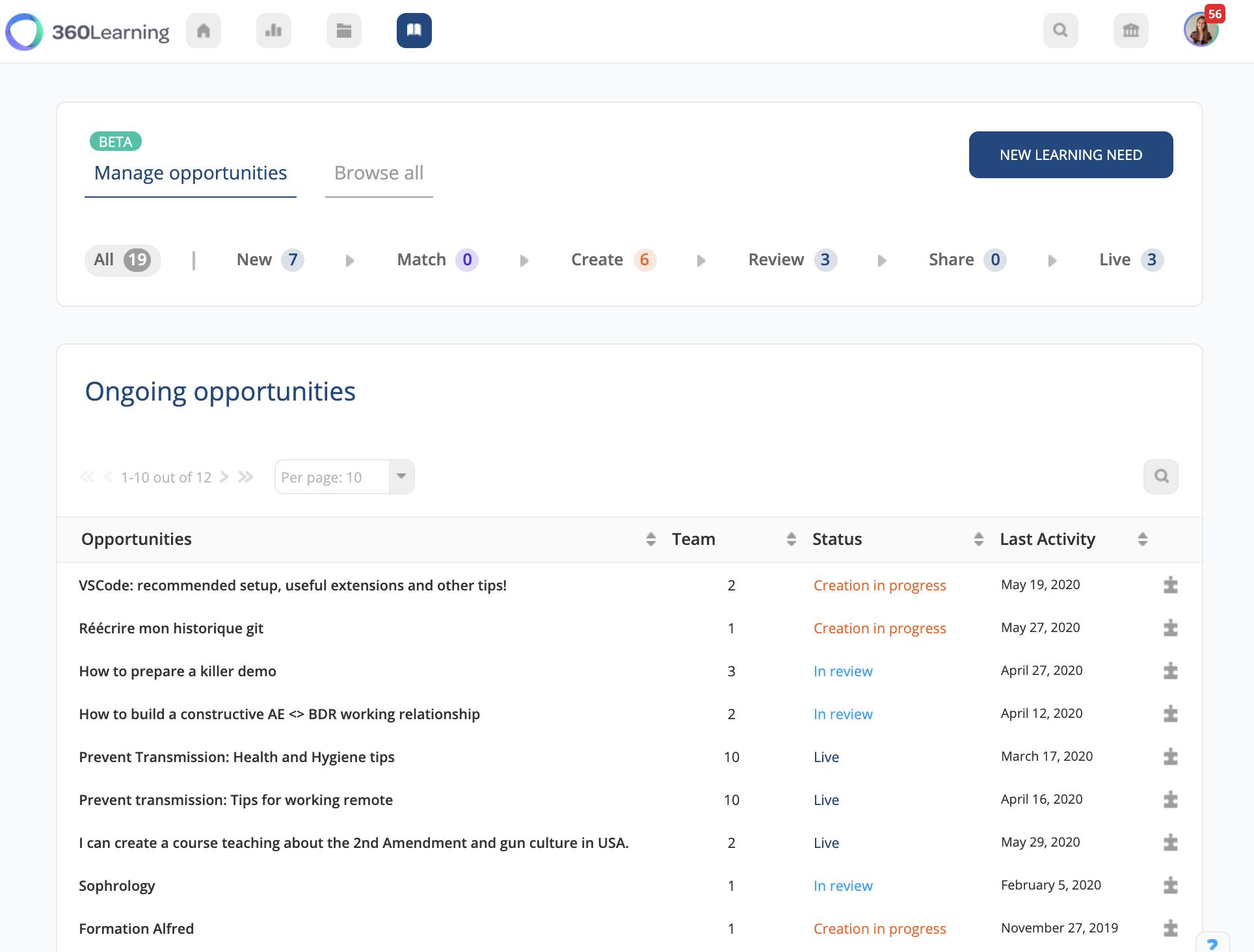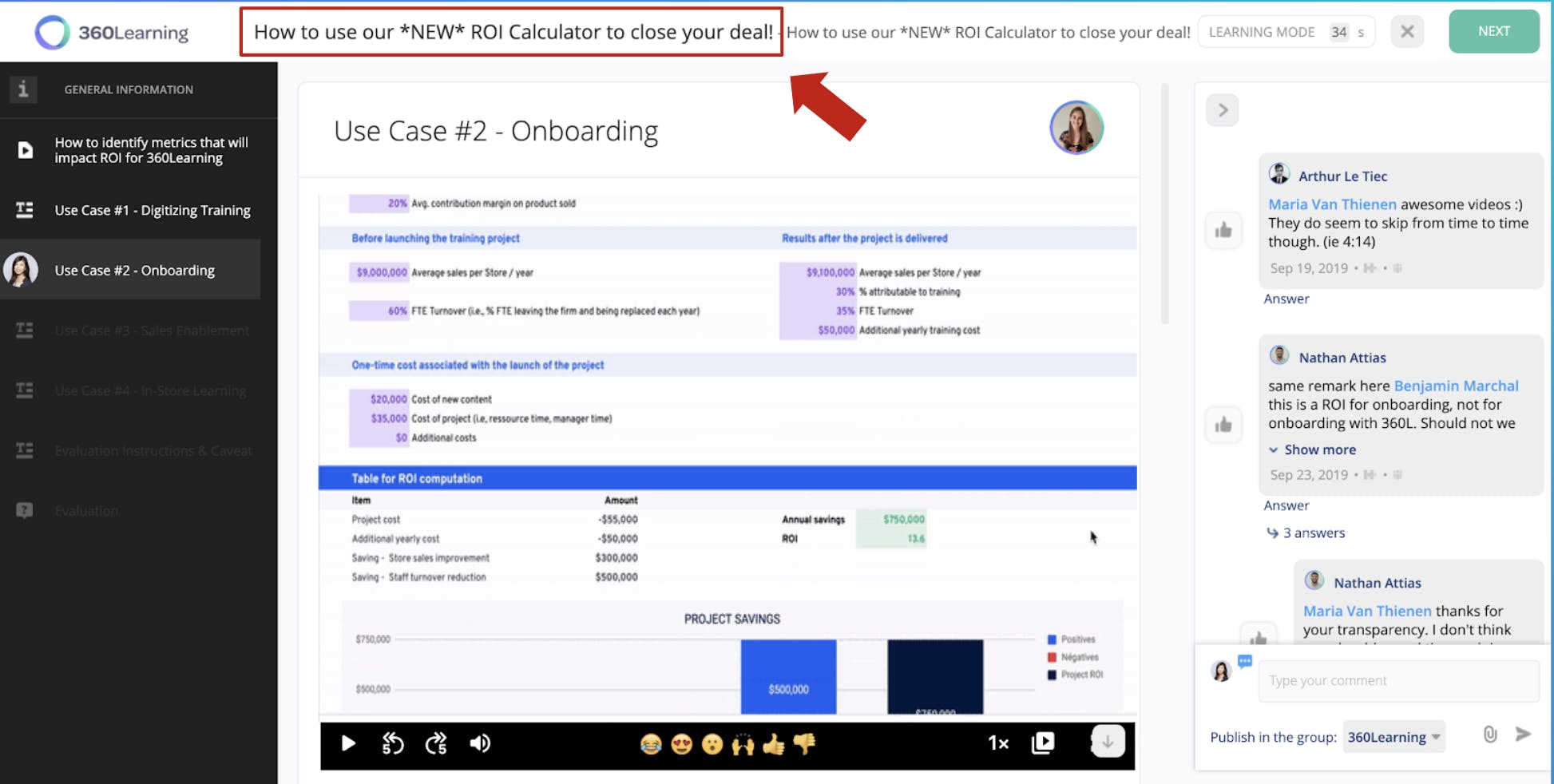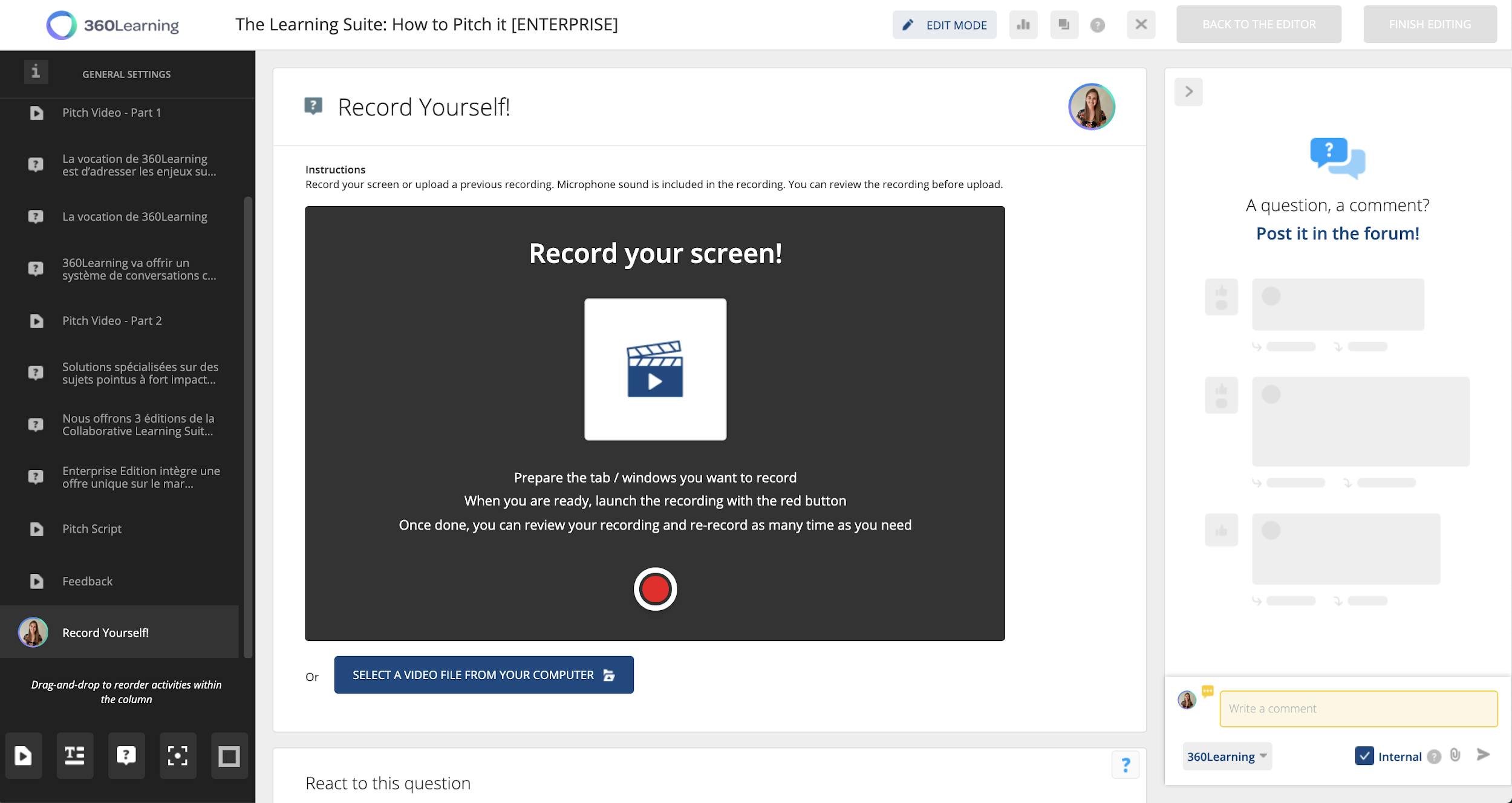In 2020, sales teams across the globe were forced to transition to remote training. For sales enablement managers, the COVID-19 pandemic has meant re-thinking existing training processes and adapting per the new constraints.
As 360Learning’s 1-woman sales enablement team, I onboard and train every salesperson joining our team – BDRs, Account Executives, and Account Managers. I’ve been doing this remotely for a while now and I’d like to share my experience with you.
Let’s kick things off by looking at the first big challenge: an overwhelming amount of training requests coming from all directions – left, right, top, bottom – at once.
Challenge #1: Juggling dozens of different types of training requests
Let’s be honest, it takes a village to properly train a sales rep.
On the one hand, you have requests from company leadership, product, marketing, operations, customer success, finance, legal, etc. for sales reps to be trained on new products, strategies, and pitches. You also have incoming requests from sales reps looking to build their expertise and skills.
On the other hand, you need to work with the subject-matter experts making those requests to deploy effective and timely trainings. For example, you need product managers to explain new features, leadership to outline company strategy, marketers to walk you through new pitches, etc. And for most trainings, there’s collaboration across multiple teams at once.
For me, this is what makes sales enablement so stimulating and fun. However, it also means a lot of different touchpoints for you and your reps.

In a single day of training, your reps might be juggling sessions with up to five different teams, and as many as ten to twenty different individuals.
This can be confusing even in a physical office. In a remote context, it can quickly become overwhelming, both for reps, and for sales enablement managers.
Fortunately, there’s a way to keep everything under control.
Three steps: Process, prioritization, and subject-matter experts
I use a three-step process to juggle different training requests:
- First, establish a clear process. If everyone in your business follows a standardized process to request training sessions with new reps, you can capture the same key information for each session. This helps you stay organized, and helps to prioritize requests. And speaking of prioritizing...
- Second, prioritize the requests. Some training requests are more urgent and impactful than others, and it’s up to us as managers to make sure the most important requests are moved to the front of the queue. This doesn’t mean ignoring certain requests but rather shipping first the trainings that are going to impact your bottom line (like a new product that can generate large upsells) and/or trainings that are urgent (like a contract process update during a quarter’s closing period).
- Third, leverage subject-matter experts. It’s a myth that sales enablement managers need to know every topic forward and backward. Our expertise is not necessarily in the information itself but on efficiently getting the information from point A to point B. For example, it would be crazy to say that an SE manager knows a product better than the product manager; but the SE manager knows how to best get the right information about that product to the sales rep. To do this effectively, we need to empower others to contribute to our training ecosystem (in this example, product managers!) This results in more pertinent training shipped faster!
Related: How We Use Peer Learning to Keep Our Company’s Competitive Edge
Here’s an illustration of how the request and project management works in practice for us:

So, that’s how I stay on top of training requests coming from all directions at once. Now, let’s talk about making sure these trainings you’re shipping are actually completed by your reps!
Challenge #2: Ensuring sales reps dedicate time to training
Our second main challenge is something that isn’t unique to remote sales training - it’s something we deal with on an ongoing basis as sales enablement managers.
I’m talking about engaging sales reps with our training.
Unsurprisingly, sales reps are more focused on prospecting than on training – as they should be! After all, the #1 goal for all of us is for them to reach their targets. Nonetheless, it is critical for them to dedicate time to training; in the long run, this will enable them to close more deals, bigger deals, and faster.
So, how can we make sure they’re engaged in their training, especially when working remotely?
I’ve got a few tips to help you out.
Three steps: Bottom line, collaboration, and the right tools
I use three techniques to encourage our sales reps to complete their training, all without detracting from their focus on completing deals:

- First, frame all training in terms of the bottom line. By drawing a direct connection between training and deals secured, you help your reps to stay interested and invested in training content. Ideally, your titles explicitly explain how this training is going to help them hit their target.
- Second, make training fun, collaborative, and competitive. With the right approach, you can make even the driest topic engaging for your sales reps. Every training session is a chance to stimulate your reps and build connections between people, and your content should reflect that. For us, this means interacting with sales reps in the training forums, launching quizzes where they compete with each other for the highest score and completion competitions where the team with the fastest completion gets a team dinner with the company co-founders (highly recommend!).
- Third, leverage tools designed for remote training. Remote training is a uniquely challenging process, but you can make it easier with the right tools. Instead of asking reps to complete activities over email (or whatever else you might be doing!), you can use a Collaborative Learning platform to easily co-create trainings and smoothly deploy them to the right reps. I know I’m biased but I can honestly say that without a platform I wouldn’t have been able to ship a quarter of the trainings I’ve shipped over the past year!
Below, an example of a key feature for remote training – pitch/demo recording for asynchronous distant evaluation! Saving you hundreds of hours of setting up live roleplays:

Finally, let’s look at how you can demonstrate your training ROI.
Challenge #3: Showing a quick return on training investments
As a sales enablement manager, I know it can be a common challenge to show the impact of your work - especially in the early stages of training.
Ramping up a sales rep takes patience and a lot of practice. It can take weeks or even months for the best sales reps to really find their rhythm. However, that doesn’t stop a lot of managers and executives wanting to see evidence of training benefits right away.
Here’s how we do it.

Three steps: Metrics, measurement, and communication
To measure the return on investment in sales enablement training, I use the following three steps - even when I’m working with my new reps remotely:
- First, identify the metric you want to impact. You can’t prove your impact if you don’t know what you’re measuring. So, focus on a clear and specific sales KPI, for example, quota attainment or time to first deal.
- Second, decide how you’re going to measure impact. You need to draw a direct line between training and impact. For example, if you launch a training on a new competitor - showing your product’s strengths and weaknesses against them – you could track the percentage of deals you secure against this competitor before and after training. An added bonus is that if you find that training to be impactful, you can double-down on competitor trainings because you know it works. So ultimately, this influences your future training strategy, too.
- Third, communicate the results. Now you have the data, you need to tell people about it. Keep things as simple as you can, and show how investments in training are contributing to the bottom line. (Our Collaborative Learning platform has an integration with Salesforce so that makes my life easier.)

Bonus tips: Keeping your sales reps motivated during a crisis
Let’s be honest, this isn’t any remote situation - we’re in a crisis. It’s a difficult time for your sales reps professionally and personally, and they need extra attention and motivation.
Here are a few extra tips to keep your sales team’s morale up:
- Stay flexible. Our way of working has changed fundamentally. As sales enablement managers, we need to stay open to new ideas and initiatives. You might find yourself working on things outside or your normal scope – that’s okay and probably best, if you are addressing the biggest bottleneck for your sales team.
- Listen to your reps. Our sales reps are an amazing source of ideas and insights during a disruption. They’re on the phone with customers a lot, and they know what they’re going through. Listen to them, and recognize their input.
- Check-in regularly. Everyone deals with disruption in different ways. Checking in with your team lets them know you’re thinking of them and are there and available to support them.
- Be creative with your communications. Not everything has to be an email or a Zoom call. Spend some time thinking about better ways to bring your team together, and ask people how they’d like to communicate so that you can adapt to their preferences.
Related: How to Support Your Front line Employees in Times of Crisis
Remote sales training can be amazing
The challenges of remote sales training are very real. But they can be overcome!
With the right set of tips and techniques, you can turn remote sales training into an opportunity to build expertise and capability, and to draw your team even closer together - no matter where you happen to be in the world.
Recently, we hosted a webinar on this topic with our partner, Close. You can take a look here for the replay.
And if you'd like to learn more about how our Collaborative Learning platform can make your life 10x easier, get in touch!



